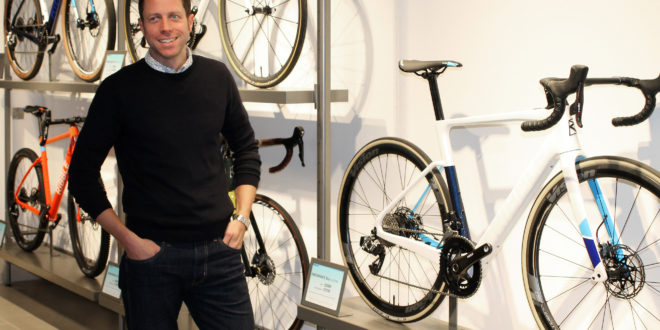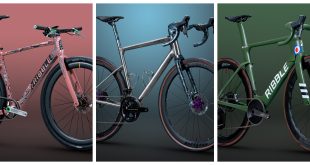Ribble has a new vision and business proposition under CEO Andy Smallwood. It is exiting the parts, accessories and clothing (PAC) part of the business to focus on bikes that are designed and built in the UK. In doing this, it is returning to its bicycle-focused heritage.
The brand has spent 120 years trading with an established cycling heritage, with most British cycling champions riding a Ribble in their career, including Chris Boardman, Bradley Wiggins and Geraint Thomas. Smallwood himself even started his racing on a Ribble and has had a deep-rooted affinity with the brand ever since. He explains: “We’re in this transition period, so we have been exiting a lot of parts, accessories and clothing stock quite aggressively to get us into the place where we need to be moving forward.
“From a bike perspective, what we’re concentrating on is the good growth we’ve seen this year, which is a result of our specific focus on it. We’ve only just released the new range, so it’s still early days in terms of growth, but early indicators on the new products are very good. It’s seen a real shift in a positive direction in terms of bike sales in the new range compared to where we were before. What we’re focusing on from a strategic perspective is working and accelerating our bike business seems to be paying off for us. By being a bit more focused on the brand as well, as opposed to selling other people’s brands, that seems to be the right thing for us to do for the future.”
He says that the successful IBDs are the ones that are focusing on what they can do well, for example providing service and fit, something that fully-online retailers aren’t able to do. Ribble has the advantage of a brick and mortar offering as well as an online business, as Smallwood explains: “That’s why we’ve got a store here, which is why we’re investing in our Preston facility as well to make sure we can offer the same. The bike fit, the touch and feel, those elements that you don’t normally get with a B2C. We try to make these stores a destination as well, so the customer wants to come in. They can see the whole range and can talk to our expert team as well.”
One thing that is key for Ribble is the design and innovation that helps the brand to differentiate itself in the marketplace. There has been heavy investment in research, development and design innovation. The bikes are designed in the UK under head of product Jamie Burrow, who is a former pro racer and U23 world champion. Smallwood says: “It’s why would a customer buy Ribble versus another brand, it’s got to come down to the fact that the product is designed specifically for a purpose, from the ground up. The new CGR range is very UK focused, for UK conditions on and off-road.
“A really important aspect of our range is that it’s designed for the intended user. We’ve got a team of people at Ribble, most people in the business actually, who are cyclists. They know the bikes that they want to ride. That’s the key thing, it’s bikes they’re proud of and that’s definitely come through in the range.”
Historically, Ribble always used to just release one bike at a time. Now, it has adopted the premise of a ‘proper’ bike brand where a whole range change will happen. But it won’t do this every year, it will do it when it feels like it’s got the research and development lined up for when it needs to change, when the marketplace requires it or when Ribble thinks it’s an area it should be going into.
Smallwood says: “Because we’re in control of the range, the product and the brand, it means we’re not in the IBD and big brands’ cycle of having to change every year. It’s a constant process of bringing new product in, trying to sell it at full price for as long as they can, then discounting it because a new range is coming. We’re out of that cycle completely, which gives us a bit of an advantage because we’re in control of that.”
Ribble has identified an opportunity in e-bikes, and Smallwood says it was one he had noticed before he even came to Ribble. He explains: “You could see that that was going to emerge as an opportunity. It needed to be a product which was designed from the ground up, it couldn’t just be a road bike with a battery bolted onto it. It had to be 100 per cent specifically designed for that intended user in that market, as it’s a different market to urban or mountain biking. The battery had to be completely concealed, it had to look and feel like a normal road bike. That market is quite traditional as it’s performance orientated, so we wanted the customer who was on it not to feel like they’re on something different to everybody else. But we also wanted to try and make it accessible as well. It’s at an accessible price point for the bike with our technology in it.”
So what has the industry’s reaction to Ribble been? Smallwood says: “I think one thing that the parts, accessories and clothing business showed us is that there isn’t a lot of customer loyalty anymore, and it takes a lot to build that. I think customers are very savvy and switched on, and the internet has changed the way people research and buy. It’s a different marketplace now to where it was. I worked in IBDs in the early part of my career and looking at the market now, it is very different to where it was.
“Before you’d walk down to your local bike shop and you wouldn’t really think about online, you’d maybe do a bit of online comparison. The barriers to entry now for online retailers are relatively low. As long as you’ve got a website and an account with the core distributors, then you can essentially set up an online retail operation. What it comes down to is two things: where you rank on Google, and the price point. There is no real loyalty unfortunately, you’ve got to earn that by offering a different service or a different product.”
The brand attended last year’s Cycle Show, where it launched a 23-model range. This marked a new brand departure and a ‘statement of intent’ of Ribble’s new vision and proposition – as Ribble has never launched a range of bikes before. Smallwood explains: “We had a big message for the show, as it would have been the first time that the consumer would have seen what we’ve been working on for the past 12 months.”
Given the innovation that has been happening at Ribble, it is pleased that customers are finally able to experience the new range and products that have been developed. Smallwood explains: “We do value the fact that a customer can touch and feel and see a bike and talk to our experts as well, talk to us. It’s good for us to talk to the customer as well to understand what the customer thinks of the range and thinks of the product.”
All bikes are individually hand built in the UK at the brand’s Preston headquarters, and that again is something that is key to Ribble, as Smallwood says: “We’re a British brand that’s doing this level of research and development and this technology, and we’ve got this product range that is competing at this sort of level, from a British brand that’s based in Preston. At the moment we’re not this big global brand that’s got all these research and development facilities, we’re a British brand that’s doing what we love to do and what we’re passionate about, which is designing and developing great bikes.”
He adds that despite certain bikes looking so different to each other, due to them being designed for different purposes, they still have the same amount of research and development put into them, to make it sure each one performs in the best way for its intended user. There is great attention to detail in every genre and product that the brand values, to make sure the bike is the best it can be for the customer buying it. Smallwood says: “Customisation is a big thing for us, that’s another differentiator versus other online retailers. Through our bike-builder, you can customise your product specification right down to fit, other people can do that, but it’s quite complex. Our bikes are built from the ground up, bespoke, which means we can offer that customisation.”
Smallwood believes because Ribble focuses on its own 100 per cent unique brand, and IBDs have their own brands that they work with, it is less of a competitor to the independents. “It’s up to the customer then, what brand do they want to buy. We’ll do our best in terms of giving them the best experience and the best product for a price point, but we’re offering a different brand and a different product to what the IBDs are offering.”
Store manager Ashley Brough adds: “It’s a different service as well almost, I think there’s always going to be a presence for retailers on the high street, it’s just how they do it and how they approach it. Look at what the high street retailers can do and not necessarily look what they can’t do, like compete on price. They can offer a physical service to customers, whether it be sizing or being shown examples of specification. You can’t hold something in your hand online.”
It’s about diversification too, as he explains: “I think that’s one thing we’ve managed to do here, is get ahead and buck the trend, and look at what other retailers have done that hasn’t worked, and build from it. Another thing we’ve done here is integrate the customer service as a bit of a hub here as well, so it serves many purposes.”
Smallwood adds: “Expert advice is critical, the guys here are all experts in cycling, and choosing the right bike and bike fit. That advice, it doesn’t matter where it is across the business, it’s still within the business.” Brough agrees: “That particular customer’s needs are met with the best agent, whether it be a return issue, or whether it be something very specific and technical based, it gets handed to the right person and dealt with by the best people in the business for it.
“We’ve got those people on hand who can speak from experience, and that’s vital. People feel so comfortable in your hands when they know that you’ve done that thing they’re trying to achieve, you’ve been there and experienced it, so they install confidence in you. It’s good having a diverse team that covers different areas and is really important in any kind of retail environment.”
He adds: “There is a real team emphasis in how we micromanage each department but they all work together. We work a lot with the digital team here, just because we use the website a lot with customers, so we pick out little bits and holes in the website where we found that customers are struggling and they’ll pick it up straight away, so it’s like micro teams working together to make the best customer journey.”
Smallwood concludes: “This is a long-term sustainable business and we’re building the foundations now in terms of brand and product development, to set us in the right place
for the future.”
 BikeBiz Bicycle and cycling retail news
BikeBiz Bicycle and cycling retail news




